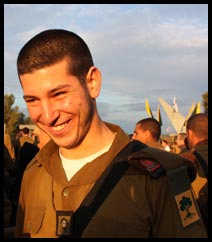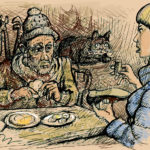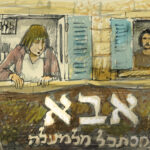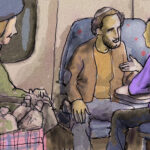Haim Watzman
This is an English translation of my annual dvar Torah for Pesach in memory of my son Niot z”l, whom we lost twelve years ago during Pesach. A pdf file of the Hebrew original, which appears in this week’s issue of “Shabbat Shalom,” the weekly Torah sheet published by Oz Veshalom, the religious peace movement, can be downloaded here .
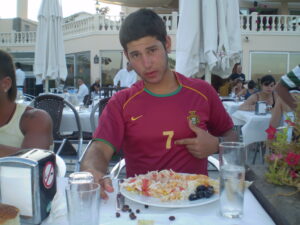
Act One: A prologue that brings the audience into the play and lays the ground for the way the acts that follow will be experienced.
Act Two: The story of the Exodus from Egypt or, more precisely, a set of stories that touch on the way the story of the Exodus is told—the Maggid.
Act Three: The sacred central ritual of eating the Pesach offering, the required festive meal, and the offering of thanks for the meal with Birkat Hamazon, the grace after the meal, and for the redemption with the psalms of the Hallel.
Act Four: The happy ending, a musical finale that raises the spirits and sends the audience out of the theater with a smile and a bounce in their step.
The first act is the most unexpected of the four parts. At first glance it looks technical and dry; it seems not to have much to do with what follows. But, in fact, the opposite is true. It is structured around two motifs that are the very essence of the subsequent acts. Without Act One, the two central acts, those of the story of the Exodus and of the eating of the offering, would be understood in an entirely different way.
Act One begins, of course, when the family and guests—the people who have together purchased and sacrificed the offering—find their places around the table or in the living room, open their Haggadot, pour the first glass of wine, and recite kiddush, the blessing over the wine and the holiday. It might seem at first that Act One ends as soon as what the Haggadah labels as the Maggid begins. But, in fact, the first paragraph of the Maggid, “Ha lahma anya,” “This is the bread of poverty,” is a bridge, a statement that creates suspense before the storytelling begins. It does so by declaring the state of oppression from which the story develops—the Egyptian enslavement. Furthermore, it points to the central symbol of Pesach since the destruction of the Temple—matzah.
We know this because the audience is not yet complete—not all the participants in the Seder have arrived. That happens only after this paragraph is read. Only after the audience declares “Kol dikhpin”, “Let all who are hungry come and eat! Let all who are needy come and partake of the Passover offering!” and after the newcomers find their places, can the telling of the story commence.
The Ben Ish Hai, Rabbi Yosef Haim of Baghdad, stresses this in his commentary on the Haggadah: “And Israel did not leave Egypt until they had concluded a covenant to treat each other compassionately, and thus ‘Let all who are hungry come and eat’ means to act compassionately.”
The Ben Ish Hai teaches two things here. First of all, the miracle of the Exodus from Egypt was conditional. For it to happen, the people had to make a covenant. But this, rather than a covenant with God, was one between the people, between each and every member of the nation and every other. This compassion does not come from heaven. Rather, it is a commitment made by every individual member of the Children of Israel to all the others.
The covenant is concluded in the wake of an action. Our first action immediately following the kiddush is to wash our hands—but without making the usual blessing. The injunction not to make the blessing immediately casts a pall over what follows. On other days we wash our hands because we are about to eat. But now, at the Seder, we wash without making a blessing because, at this stage, we eat too little to be commanded to offer thanks for it.
The Ben Ish Hai explains, in a different work of his:
It is a reminder of the reason for the enslavement and its oppression, which was because of the sale of Joseph the Righteous, may peace be on him, whose opulent tunic they dipped in blood and they sold him, thus causing grief to Jacob Our Father, may peace be on him, and that is hinted at in the karpas [the green vegetable we eat after washing], which can be divided into the letters kar, are the last two letters of the word mekher [sale], and the letters pas, which are the first two letters of pasim [opulent].
According to the Ben Ish Hai, we eat karpas at the beginning of the Seder to remind ourselves that the entire story that we will soon tell in Act Two began with a deed that was the inverse of compassion, an act of hatred and jealously. The word “karpas” reminds us of the crime, while the eating of a tiny, insufficient portion denies us the connection with God that we have when we partake of a meal and make the requisite blessings before and after eating.
Between karpas and kol dikhpin comes yahatz, the breaking of the middle matzah, which symbolizes rupture and want.
To summarize: In Act One of the Seder, the audience gathers, and we begin, as we do on every holiday, with kiddush. We expect to go straight into a festive meal, but then everything goes wrong. After kiddush we wash our hands, as we usually do, but do not make a blessing. The audience is discomfited. Then we eat, but not bread (matzah), but only stem or a leaf, the tiniest bit, too little to enjoy—this reminds us of the sale of Joseph. And then comes heartbreak—we split the middle matzah. At the end of the act we hold up the bread of affliction and perform an atonement for the sin. We invite anyone waiting outside, anyone who has nowhere to celebrate, nowhere to eat, who is alone, to come in and join us. In this we take upon ourselves the covenant of compassion.
At the beginning of Act Two, when we begin to tell the story of the Exodus, we are thus in a very specific mindset. We are aware of the sin that caused the nation to descend to Egypt. And we are aware, on our very flesh, of the necessary condition for redemption. God took us out of Egypt, but we ended up there in the first place because we did not know how to accept each other. We are redeemed not because we are a chosen people but because we chose ourselves to enter into the covenant of compassion. It is with this in our minds that we listen to the story that constitutes us as a nation.
This covenant of compassion is not one of kinship and unity in the simplistic sense of those words. Many Jews like to proclaim and laud unity, but all too often they mean a unity in which everyone is alike. They believe in a unity in which everyone unites behind them and becomes like them. There are religious Jews who want us to unite in the observance of the commandments and Zionists who want us to unite in loyalty to the Jewish State. There are right-wingers who want us to unite around the nation and leftists who want us to unite around democracy. The Ben Ish Hai has something else in mind. No one chooses their brothers and sisters. Joseph’s brothers had good reasons to dislike him. When we open the door and invite all those who are hungry and all who are needy to join us, we don’t know who will walk in. We have to accept each guest as they are, with their customs and opinions.
What is compassion if not seeing each other person as deserving of help, as having an unconditional right to be part of us? Such compassion is the basic law on which our society is founded.
Please help the Niot Project, an educational program we established in Niot’s memory, work with Israeli teenagers coping with learning difficulties. To make an online donation, click here.
******
Previous thoughts on Pesach in memory of Niot:
The Hole in the Haggadah
Henry V’s Distressful Bread (2021)
How Should We Tell the Story? (2020)
The Four Slaves (2019)
The Third Child (2018)
Who Walks In? (2017)
The Missing Center (2016)
The Question of Questions (2015)
The Bitterness of Egypt (2012)
